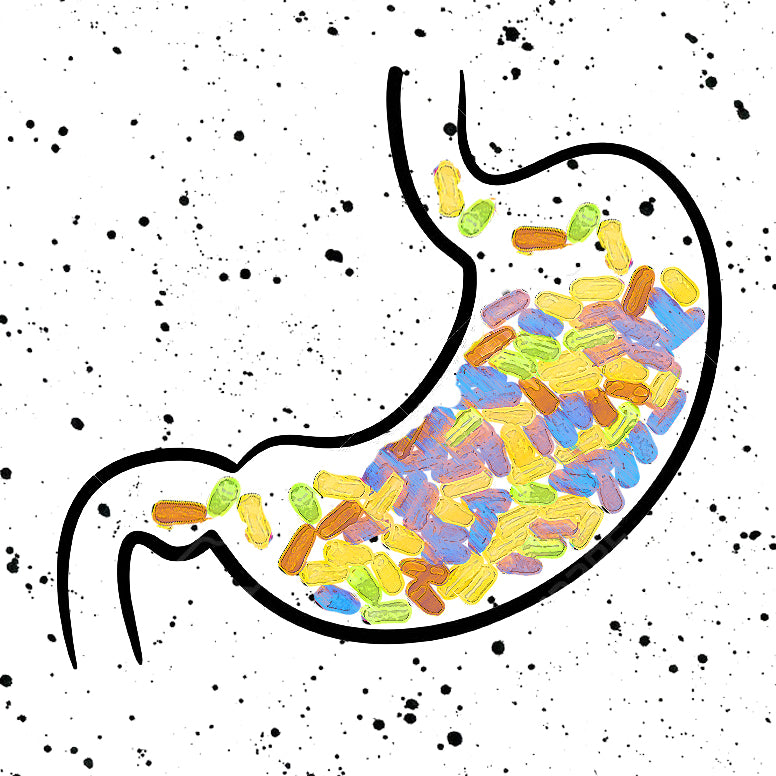
In the battle between kefir and kombucha and which is healthier, it sometimes comes down to the difference between Lactic Acid Bacteria (LAB) and Acetic Acid Bacteria (AAB). Kefir has LAB (mostly) and Kombucha has AAB (mostly). Veggies are fermented by LAB. Sourdough has both LAB and AAB.
Lactic acid bacteria (LAB) and Acetic acid bacteria (AAB) both preserve foods by consuming sugars (lactose, sucrose, glucose, etc) and turning them into acids (lactic or acetic acid or another acid).
However, they are both very different in flavor and function for humans. You find LAB's in kefir (especially milk kefir) and you find AAB's in kombucha and to a lesser degree water kefir and ginger beer.
What is Lactic Acid Bacteria (LAB)?
LAB are bacteria that do well in a high acidic (low pH) environment. They create lactic acid as they consume the sugar (lactose, glucose) and that gives them the ability to naturally ferment foods safety without allowing spoilage bacteria and other pathogens to enter.
Even though there are many strains that are classified as LAB, the most common studied genus is Lactobacillus.
What are the benefits of LAB?
LAB live in the gut and if you eat them they have the potential to either temporarily help the balance or they may even take up residence within the intestines.
The most obvious benefit is that they allows you to digest lactose easier, but they also have many other health benefits that have been studied.
LAB's help regulate bowel movement. Multiple studies show that it helps alleviate constipation and possible may ease suffers of IBS.
LAB's can also help improve immune function which in turn helps prevent infections, colds and the flu. In one study, LAB's were shown to stimulate and modulate cytokine production in order to help prevent illness.
Along the same lines, there is plenty of research showing how LAB's prevent and stall the progression of cancer. Not just colon cancer, but also leukemia, breast cancer and skin cancer.
LAB's have also reportedly been shown to slow fat-cell growth and help weight loss.
Kefir is high in lactic acid bacteria, especially milk kefir. Lactic acid bacteria are also what drive veggie ferments such as sauerkraut and kimchi.
What is Acetic Acid Bacteria (AAB)?
AAB in ferments are the bacteria primarily responsible for Acetic Acid. Most people think of acetic acid as vinegar because vinegar is basically made up of acetic acid and water.
The AAB consume sugars and create acetic acid and sometimes other acids. This bacteria is the primary driver in kombucha ferments. Water kefir and ginger beer ferments are driven mostly by Lactic Acid Bacteria (LAB), but the AAB usually still take a role, albeit a lesser role.
Acetic acid bacteria need oxygen to survive, so that's why you need an open lid for kombucha ferments. But it also means that the AAB will not survive the stomach as there is not enough oxygen. Studies of human gut bacteria have not found AAB for this reason. AAB are generally not considered probiotic, at least in terms of human guts.
Lactic Acidic Bacteria are different in that they do survive in the gut and have many health giving properties as live probiotics.
So basically the benefit of acetic acid bacteria is not the bacteria itself, but the by-products of the bacteria such as acetic acid.
Acetic acid has many benefits that have been studied. Some of the biggest is that it helps control blood sugar, lowers blood pressure and inflammation.
Taste difference
Acetic acid is more sour and more pungent than lactic acid. Lactic acid has a smoother creamier tang to it.
Acetic acid bacteria in Water kefir and ginger beer plant
In most studies, water kefir and ginger beer plant have some measure of acetic acid bacteria. This will add to the sourness / tartness of the drink. If you want more of that sour vinegar flavor, make sure you are using an open lid as that will help the acetic acid bacteria thrive. If you are looking primary for a lactic acid bacteria ferment without acetic acid, use a closed lid or airlock to cut off the oxygen supply.
Bottom line
LAB's and AAB's are hard to compare as LAB's are probiotic in nature as the live bacteria interact with your own stomach bacteria. AAB's are not directly probiotic as they need oxygen to survive and will have little to no impact directly on your gut. However, they do produce healthy by-products such as acetic acid that is beneficial for health.
The amazing thing about these cultures is that they serve different purposes and have different health benefits. Milk kefir, water kefir and ginger beer are great probiotics. Kombucha is certainly a healthy ferment due to the by-products of fermentation (just like sourdough), but its not a probiotic powerhouse by itself. It's something that is rarely talked about in the industry. The yeast in kombucha may be considered probiotic by some experts, but the bacteria that survive is not really probiotic. Consuming both a lactic ferment (like kefir) as well as an acetic ferment (like kombucha) helps bring an important diversity to your diet and your gut.
Do you prefer lactic acid bacteria ferments like kefir and fermented vegetables or acetic acid bacteria ferments like kombucha?


Comments
Yemoos Nourishing Cultures
Hi Karen,
Those are all great questions.
There are many other yeasts in milk kefir that are not candida and they have many studied benefits. Even though yeast and candida have been given a bad name, yeast is an essential part of the microbiome. It’s only when the balance is off or if there’s too much of one strain that issues may arise. Kefir represents a microbiome in itself and when done right will have the bacteria and yeast already balanced. It’s my belief that a diverse balanced drink is more important for health than just bacteria by itself, even for those with yeast issues.
But the yeast can be kept at a minimum. If you do have candida or sensitives to yeast, then I would highly recommend making kefir out of raw milk (if possible). The natural bacteria in the milk will keep the opportunistic yeast to a minimum and help the bacteria. Sometimes with pasteurized milk, you will get those errant yeasty batches that may not be good for some people. If you have high quality grass fed raw milk, you can’t really go wrong.
You can do yogurts or ferment milk kefir above 95 degrees and the yeast will be extremely low. For some who are extra sensitive, that may be the best option. Otherwise, a healthy balanced kefir with a diverse mix of bacteria and yeast is recommended.
July 08, 2019
Keren Graham
Hi Nathan,
This article was very helpful. Thank you.
I’m trying to find somebody who can answer this question. I had a batch of milk kefir tested at a laboratory here in NZ, because I wanted to know what I was ingesting. The bacteria cultures grown were fine, but the report showed 9500 colonising units of yeast (which I assume is candida).
I’ve been reading a lot about yeast and the negative impact it can have on health, especially if an overgrowth of candida is already present.
What I want to know is does the ingested yeast (candida) from milk kefir survive the digestion process and therefore add to the problem, or not?
I’ve contact Mad Millie because I see on their milk kefir culture, that the yeast used is candida. I am waiting for a food technician to get back to me but so far no luck.
I’m all for milk kefir as I did notice the health benefits, but I am questioning the yeast content and if it is the right thing for me, and other people with candida related issues, to be taking.
Many thanks
July 08, 2019
Leave a comment